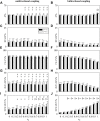Assessing cardiorespiratory interactions via lagged joint symbolic dynamics during spontaneous and controlled breathing
- PMID: 37602202
- PMCID: PMC10436098
- DOI: 10.3389/fnetp.2023.1211848
Assessing cardiorespiratory interactions via lagged joint symbolic dynamics during spontaneous and controlled breathing
Abstract
Introduction: Joint symbolic analysis (JSA) can be utilized to describe interactions between time series while accounting for time scales and nonlinear features. JSA is based on the computation of the rate of occurrence of joint patterns built after symbolization. Lagged JSA (LJSA) is obtained from the more classical JSA by introducing a delay/lead between patterns built over the two series and combined to form the joint scheme, thus monitoring coordinated patterns at different lags. Methods: In the present study, we applied LJSA for the assessment of cardiorespiratory coupling (CRC) from heart period (HP) variability and respiratory activity (R) in 19 healthy subjects (age: 27-35 years; 8 males, 11 females) during spontaneous breathing (SB) and controlled breathing (CB). The R rate of CB was selected to be indistinguishable from that of SB, namely, 15 breaths·minute-1 (CB15), or slower than SB, namely, 10 breaths·minute-1 (CB10), but in both cases, very rapid interactions between heart rate and R were known to be present. The ability of the LJSA approach to follow variations of the coupling strength was tested over a unidirectionally or bidirectionally coupled stochastic process and using surrogate data to test the null hypothesis of uncoupling. Results: We found that: i) the analysis of surrogate data proved that HP and R were significantly coupled in any experimental condition, and coupling was not more likely to occur at a specific time lag; ii) CB10 reduced CRC strength at the fastest time scales while increasing that at intermediate time scales, thus leaving the overall CRC strength unvaried; iii) despite exhibiting similar R rates and respiratory sinus arrhythmia, SB and CB15 induced different cardiorespiratory interactions; iv) no dominant temporal scheme was observed with relevant contributions of HP patterns either leading or lagging R. Discussion: LJSA is a useful methodology to explore HP-R dynamic interactions while accounting for time shifts and scales.
Keywords: autonomic nervous system; cardiac control; coupling strength; heart rate variability; nonlinear interactions; phase relationship; respiratory sinus arrhythmia.
Copyright © 2023 Cairo, Bari, Gelpi, De Maria and Porta.
Conflict of interest statement
The author(s) AP, BDM, FG, VB, BC declared that they were an editorial board member of Frontiers, at the time of submission. This had no impact on the peer review process and the final decision.
Figures







Similar articles
-
Cardiorespiratory coupling strength in athletes and non-athletes.Respir Physiol Neurobiol. 2022 Nov;305:103943. doi: 10.1016/j.resp.2022.103943. Epub 2022 Jul 11. Respir Physiol Neurobiol. 2022. PMID: 35835289
-
On the Different Abilities of Cross-Sample Entropy and K-Nearest-Neighbor Cross-Unpredictability in Assessing Dynamic Cardiorespiratory and Cerebrovascular Interactions.Entropy (Basel). 2023 Apr 1;25(4):599. doi: 10.3390/e25040599. Entropy (Basel). 2023. PMID: 37190390 Free PMC article.
-
Lack of association between heart period variability asymmetry and respiratory sinus arrhythmia in healthy and chronic heart failure individuals.PLoS One. 2021 Feb 16;16(2):e0247145. doi: 10.1371/journal.pone.0247145. eCollection 2021. PLoS One. 2021. PMID: 33592077 Free PMC article.
-
The phylogeny and ontogeny of autonomic control of the heart and cardiorespiratory interactions in vertebrates.J Exp Biol. 2014 Mar 1;217(Pt 5):690-703. doi: 10.1242/jeb.086199. J Exp Biol. 2014. PMID: 24574385 Review.
-
Cardiorespiratory coupling in health and disease.Auton Neurosci. 2013 Apr;175(1-2):26-37. doi: 10.1016/j.autneu.2013.02.006. Epub 2013 Mar 13. Auton Neurosci. 2013. PMID: 23497744 Free PMC article. Review.
Cited by
-
Relationship between the autonomic nervous system and cerebral autoregulation during controlled breathing.Eur J Appl Physiol. 2025 Aug 18. doi: 10.1007/s00421-025-05933-9. Online ahead of print. Eur J Appl Physiol. 2025. PMID: 40824440
-
Detection of respiratory frequency rhythm in human alpha phase shifts: topographic distributions in wake and drowsy states.Front Physiol. 2025 Jan 6;15:1511998. doi: 10.3389/fphys.2024.1511998. eCollection 2024. Front Physiol. 2025. PMID: 39835197 Free PMC article.
References
-
- Abreu R. M., Catai A. M., Cairo B., Rehder-Santos P., De Maria B., Vaini E., et al. (2019). “Assessment of the coupling strength of cardiovascular control via joint symbolic analysis during postural challenge in recreational athletes,” in Proceedings of the Annual International Conference of the IEEE Engineering in Medicine and Biology Society, Berlin, Germany, 23-27 July 2019 (IEEE; ), 2011–2014. - PubMed
-
- Abreu R. M., Catai A. M., Cairo B., Rehder-Santos P., Silva C. D., Favari Signini E., et al. (2020). A transfer entropy approach for the assessment of the impact of inspiratory muscle training on the cardiorespiratory coupling of amateur cyclists. Front. Physiol. 11, 134. 10.3389/fphys.2020.00134 - DOI - PMC - PubMed
-
- Akaike H. (1974). A new look at the statistical model identification. IEEE Trans. Autom. Control 19, 716–723. 10.1109/tac.1974.1100705 - DOI
LinkOut - more resources
Full Text Sources
Research Materials
Miscellaneous

